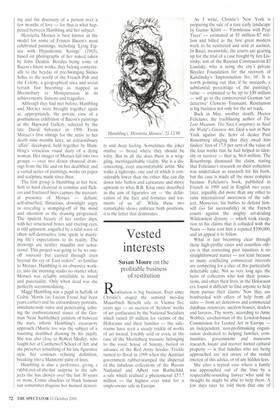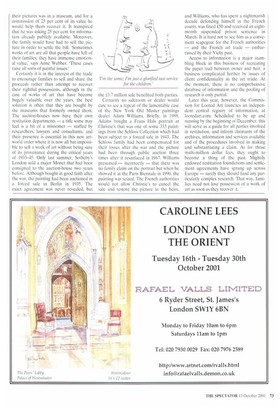Vested interests
Susan Moore on the profitable business of restitution Restitution is big business. Ever since Christie's staged the seminal two-day Mauerbach Benefit sale in Vienna five years ago — an auction of 'heirless' works of art confiscated by the National Socialists which raised £9 million for victims of the Holocaust and their families — the salerooms have seen a steady trickle of works of art looted, forcibly sold or even, in the case of the Moritzburg treasure belonging to the royal house of Saxony, buried in advance of the Red Army hordes. Trickle turned to flood in 1999 when the Austrian government rubber-stamped the dispersal of the fabulous collections of the Barons Nathaniel and Albert von Rothschild, a sale which realised a phenomenal £57.7 million — the highest ever total for a single-owner sale in Europe.
As I write, Christie's New York is preparing the sale of a rare early landscape by Gustav Khan — 'Farmhouse with Pear Trees' — estimated at $5 million–$7 million and billed as the first great modern work to be restituted and sold at auction. In Basel, meanwhile, the courts are gearing up for the trial of a case bought by Jen Lissitsky, son of the Russian Constructivist El Lissitsky, who is suing the city's private Beyeler Foundation for the recovery of Kandinsky's 'Improvisation No. 10'. It is worth pointing out that, if he succeeds, a substantial percentage of the painting's value estimated to be up to $30 million — will go to the controversial German 'art detective' Clemens Toussaint, Restitution is big business not only for the art trade.
Back in May, another sleuth, Hector Feliciano, the trailblazing author of The Lost Museum: The Nazi Conspiracy to Steal the World's Greatest Art, filed a suit in New York against the heirs of dealer Paul Rosenberg alleging that they owed him finders' fees of 17,5 per cent of the value of the four works that he had helped to identify or recover — that is, $6.8 million. The Rosenbergs dismissed the claim, stating that Feliciano's research on their collection was undertaken as research for his book, but the case is made all the more complex because Feliciano's book, published in French in 1995 and in English two years later, arguably did more than any other to raise international awareness of the subject. Moreover, his battles to defend himself (so far successfully) in the French courts against the mighty art-dealing Wildenstein dynasty — which took exception to his claims that it colluded with the Nazis — have cost him a reputed $100,000, and an appeal is to follow.
What is fast becoming clear through these high-profile cases and countless others is that correcting past injustices is no straightforward matter — not least because so many conflicting commercial interests are competing for a slice of this particularly delectable cake. Not so very long ago, the heirs of collectors who lost their possessions, and often their lives, in the Holocaust era found it difficult to find anyone to help them pursue their claims. Now they are bombarded with offers of help from all sides — from art detectives and commercial database resources, auction-houses, dealers and lawyers. The worry, according to Anne Webber, co-chairman of the London-based Commission for Looted Art in Europe — an independent, non-profitrnaking organisation dedicated to helping families, communities, governments and museums research, locate and recover looted cultural property — is that families who are being approached are not aware of the vested interest of this advice, or of any hidden fees.
She cites a typical case where a family was approached out of the blue by a respectable-sounding lawyer who said he thought he might be able to help them. A few days later he told them that one of their pictures was in a museum, and for a commission of 25 per cent of its value he would help them recover it. It transpired that he was asking 25 per cent for information already publicly available. Moreover, the family would have had to sell the picture in order to settle the bill. 'Sometimes works of art are all that people have left of their families; they have immense emotional value,' says Anne Webber. 'These cases raise all sorts of painful issues.'
Certainly it is in the interest of the trade to encourage families to sell and share the proceeds rather than attempt to recover their rightful possessions, although in the case of works of art that have become hugely valuable over the years, the best solution is often that they are bought by the museums that formerly owned them. The auction-houses now have their own restitution departments — a title some may feel is a bit of a misnomer — staffed by researchers, lawyers and consultants, and their presence is essential in this new artworld order where it is now all but impossible to sell a work of art without being sure of its provenance during the critical years of 1933-45. Only last summer, Sotheby's London sold a major Monet that had been consigned to the auction-house two years before. Although bought in good faith after the war, the painting had been auctioned in a forced sale in Berlin in 1935. The exact agreement was never revealed, but the £3.7 million sale benefited both parties.
Certainly no saleroom or dealer would care to see a repeat of the lamentable case of the New York Old Master paintings dealer Adam Williams. Briefly, in 1989, Adams bought a Frans Hals portrait at Christie's that was one of some 333 paintings from the Schloss Collection which had been subject to a forced sale in 1943. The Schloss family had been compensated for their losses after the war and the picture had been through public auction three times after it resurfaced in 1967. Williams presumed — incorrectly — that there was no family claim on the portrait but when he showed it at the Paris Biennale in 1990, the painting was seized. The French authorities would not allow Christie's to cancel the sale and restore the picture to the heirs, and Williams, who has spent a nightmarish decade defending himself in the French courts, was fined £50 and received an eightmonth suspended prison sentence in March. It is hard not to see him as a convenient scapegoat for the French authorities — and the French art trade — embarrassed by their Vichy past.
Access to information is a major stumbling block in this business of recreating the paper trail between owner and heir, a business complicated further by issues of client confidentiality in the art trade. At the moment, there is no comprehensive database of information and the pooling of research is only partial.
Later this year, however, the Commission for Looted Art launches an independent central registry of information, at lootedarecom. Scheduled to be up and running by the beginning of December, this will serve as a guide for all parties involved in restitution, and inform claimants of the archives, information and services available and of the procedures involved in making and substantiating a claim. As for those multi-million dollar fees, they ought to become a thing of the past. Mightily endowed restitution foundations and settlement agreements have sprung up across Europe — surely they should fund any particularly complex research. That way, families need not lose possession of a work of art as soon as they recover it.



























































































 Previous page
Previous page